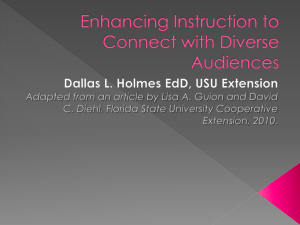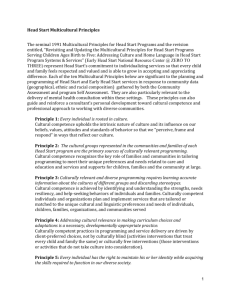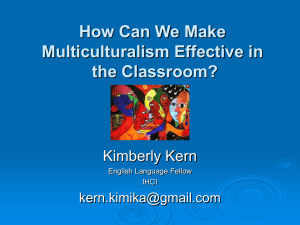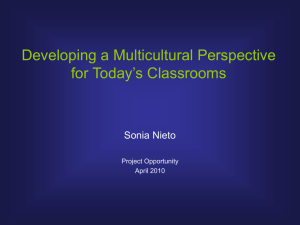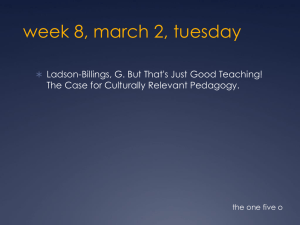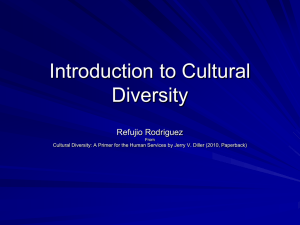Chisholm, I. M. (1994). Preparing Teachers for Multicultural
advertisement
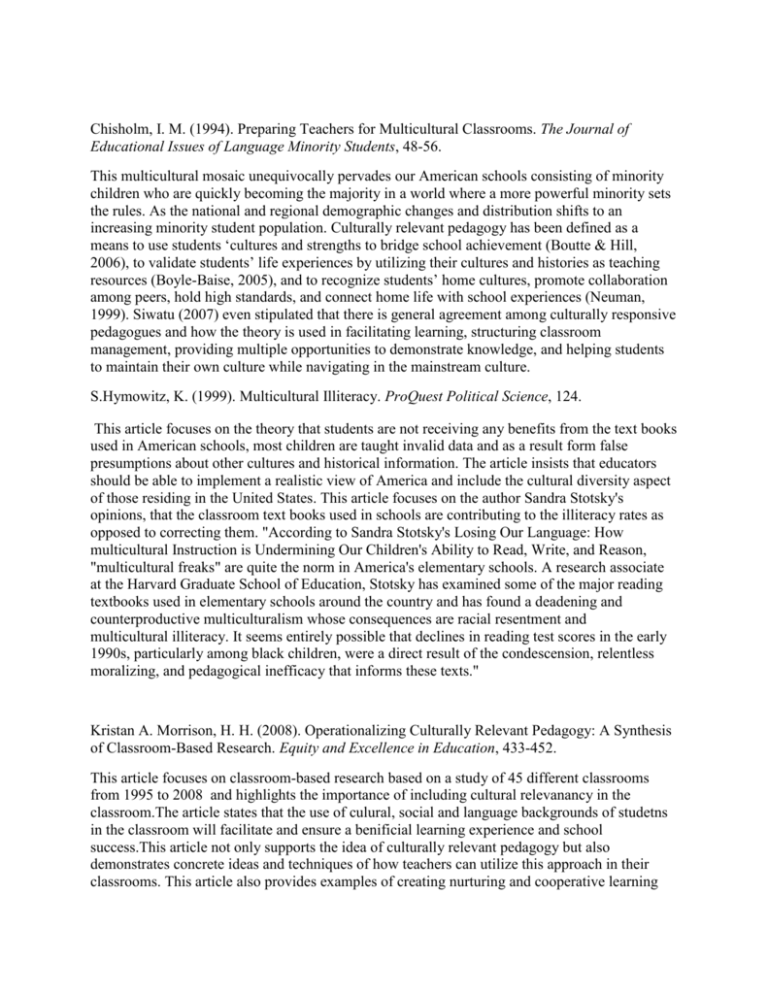
Chisholm, I. M. (1994). Preparing Teachers for Multicultural Classrooms. The Journal of Educational Issues of Language Minority Students, 48-56. This multicultural mosaic unequivocally pervades our American schools consisting of minority children who are quickly becoming the majority in a world where a more powerful minority sets the rules. As the national and regional demographic changes and distribution shifts to an increasing minority student population. Culturally relevant pedagogy has been defined as a means to use students ‘cultures and strengths to bridge school achievement (Boutte & Hill, 2006), to validate students’ life experiences by utilizing their cultures and histories as teaching resources (Boyle-Baise, 2005), and to recognize students’ home cultures, promote collaboration among peers, hold high standards, and connect home life with school experiences (Neuman, 1999). Siwatu (2007) even stipulated that there is general agreement among culturally responsive pedagogues and how the theory is used in facilitating learning, structuring classroom management, providing multiple opportunities to demonstrate knowledge, and helping students to maintain their own culture while navigating in the mainstream culture. S.Hymowitz, K. (1999). Multicultural Illiteracy. ProQuest Political Science, 124. This article focuses on the theory that students are not receiving any benefits from the text books used in American schools, most children are taught invalid data and as a result form false presumptions about other cultures and historical information. The article insists that educators should be able to implement a realistic view of America and include the cultural diversity aspect of those residing in the United States. This article focuses on the author Sandra Stotsky's opinions, that the classroom text books used in schools are contributing to the illiteracy rates as opposed to correcting them. "According to Sandra Stotsky's Losing Our Language: How multicultural Instruction is Undermining Our Children's Ability to Read, Write, and Reason, "multicultural freaks" are quite the norm in America's elementary schools. A research associate at the Harvard Graduate School of Education, Stotsky has examined some of the major reading textbooks used in elementary schools around the country and has found a deadening and counterproductive multiculturalism whose consequences are racial resentment and multicultural illiteracy. It seems entirely possible that declines in reading test scores in the early 1990s, particularly among black children, were a direct result of the condescension, relentless moralizing, and pedagogical inefficacy that informs these texts." Kristan A. Morrison, H. H. (2008). Operationalizing Culturally Relevant Pedagogy: A Synthesis of Classroom-Based Research. Equity and Excellence in Education, 433-452. This article focuses on classroom-based research based on a study of 45 different classrooms from 1995 to 2008 and highlights the importance of including cultural relevanancy in the classroom.The article states that the use of culural, social and language backgrounds of studetns in the classroom will facilitate and ensure a benificial learning experience and school success.This article not only supports the idea of culturally relevant pedagogy but also demonstrates concrete ideas and techniques of how teachers can utilize this approach in their classrooms. This article also provides examples of creating nurturing and cooperative learning environments and connecting school learning to student’s identinities. This article is rich in cultural relevant strategies to impliment into the classroom which fosters student development and personal growth. Ladson-Billings, G. (1995). Toward a Theory of Culturally Relevant Pedegogy . American Educational Research Journal , 465-491. This article focuses on Ladson-Billings research on culturally relevant pedagogy. LadsonBillings firmly states that schools should be culturally compatible and make connections between the student and the student’s home lifestyle. Ladson-Billings mentions that discovering small differences in students social interactions make a big difference in the interactional ways that students engage in the content of the school curriculum. Ladson-Billings discusses that making small progressions daily in everyday participation may be one way to develop culturally relevant pedagogy. Ladson-Billings conducts research experiments based on other teacher’s personal experiences and reflections and her own findings. Langhout, J. M. (2011). Cultivating Agents of Change in Children. Theory and Research in Social Education, 61-91. This article offers various practices used to service the culturally relevant data in the classroom through an artistic form. The article focuses on a first grade teacher’s attempt to create an artistbased on multicultural curriculum. This article incorporates Dewey’s and Gramci’s critical schooling theories and links them to the nine month study of how a teacher in a rural location of California persues to incorporate multicultural education into her classroom. The article covers social change as well as the demographics of the school, classroom , the teacher and the community.The main objective of this study is to expose students to various artists, musicians, poets, painters, choreographers, students would watch documentaries and read books observe their work and study on how each artist was inspired and affected by their race, gender, ableness , class status . Students create their own art work and have peer reflection sessions on the knowledge they have gained on each artist figure. The basis of this study is to introduce ethnography into the curriculum. The article lists the conflicts that took place during this study as well as the positive effects it had on the students learning experiences and offer reflective analysis from the teacher. Meacham, S. J. (2001). Vygotsky and the Blues:Re-Reading Cultural Connections and Conceptual Development. Theory Into Practice, 190-196. This article the theorists who support culturally relevant pedagogy and Vygotsky’s views on the learning styles of students based on their cutlural backgrounds. Vygotsky’s theories support the ideas that children’s learning patterns stem from home and are later enhanced in the basis of the classroom. This article underlies that knowing a student’s background will benefit the child’s overall learning process and applying culturally related data into the classroom with enrich the child’s learning development and promote a higher order of thought process. Montgomery, C. (n.d.). Caught Between Regulations and Meaning: Fifth Grade Students and their Teachers Respond to Multicultural Children's Literature. This study explored how authentic ethnic literature could supplement core curriculum in the in an effort to help teachers and students connect across their cultural and linguistic differences. This article employs realistic examples of how to connect cultural aspects into the classroom by providing a connection to the Latino culture through the use of a read aloud. By initiating a peer discussion as a technique to incorporate with picture book read aloud gives an insight into the Latino culture, thus betters the cultural understanding in the classroom. Morgan, H. (2010). Teaching Styles Can Make a Big Difference. Educuational Horizons, 11420. Morgan Hani discusses the differences in learning styles among various ethnic groups. She explained that students from different culture learning differently. In her extensive research she found that minority students encounter problems adapting or adjusting in schools than mainstream students. She noticed they lack the knowledge, communication, and learning styles when learning. This resulted when the “teaching styles did not match the ways they communicate and learn. “According to Morgan Hani teachers may encounter cultural conflicts when teaching diverse groups of students and emphasize how students from different cultures learn differently. African American and Latino students, for example, tend to improve academically with cooperative learning methods of teaching. Schultz, S. (2010). Judging a Book by it's Cover. San Rafael: Multicultural Children's Literature. Schultz discusses the cultural differentiation within the public school system. She mentions the inequality that children are receiving based on the instructional use of the teachers. Schultz's focal point is literacy and she mentions that it is necessary to teach content that is culturally relevant to validate each student’s previous experiences. Schultz conducts research to achieve a clearer understanding of how to apply multicultural aspects into the curriculum particularly into literacy learning in the classroom. Schultz provides an evaluation model for teachers to implicate into their classrooms when selecting and evaluating multicultural texts for inclusion into the reading curriculums. Young, E. (2010). Challenges to Conceptualizing and Actualizing Culturally Rerlevant Pedagogy. Journal of Teaching Education, 248-60. This is a critical case study as well as an action research piece; it is conducted by educators and administrators who discuss cultural relevancy in pedagogy. This journal emphasizes on building multicultural relevance based on collected data from previous case studies that show insights on the outcomes of their former studies. This article also discusses the training of educators on cultural relevance as well as the harsh nature of racism and how to address these sensitive matters in the classroom. This article stresses the importance of getting to know each student's cultural background to better assist them in their learning needs. The article also discusses the importance of students knowing their backgrounds and being proud of their heritage and not to change that to be able to "fit in". Young underwent a research experiment of eight participants in one school and observed and recorded data which was based on culturally relevant lessons provided by the teachers and executed in their classrooms. Young concluded that although the research has proven that it has changed the mentality of cultural awareness being taught in the classroom more efficiently and not just limit it to cultural holidays and cultural foods. However, eight weeks of inquiry is not a sufficient amount of time to make such conclusions and raising cultural awareness should be a reflective and ongoing process created gradually by the educators in the pedagogical field. Zhang, J. (2001). Cultural Diversity in Instructional Design. International Journal of Instructional Media , 299-307. This article explains how certain cultures have different learning styles and ethnic styles when learning in the classroom. Mr. Zhang completed an extensive study on American Indians, Asian Americans, African Americans, and Hispanic Americans regarding their learning habits and how they learn. He explained how each ethnic group managed their time, how differently they learn in cooperative groups, and how they revered and respect their teachers. Zhang also discussed how these different cultures are disciplined in the classroom. Zhang urges that just as cultural sensitivity is applied in the world it should also have the same respect in the classroom setting and instructional design. Zhang brings forth the notions that educators have a set of their own beliefs but those beliefs should be waved when entering the classroom curriculum due to the diversity of the students in their class. When addressing any subject Zhang insists that Educators should value the cultural backgrounds of their students and apply various culturally relevant methods into their learning.
